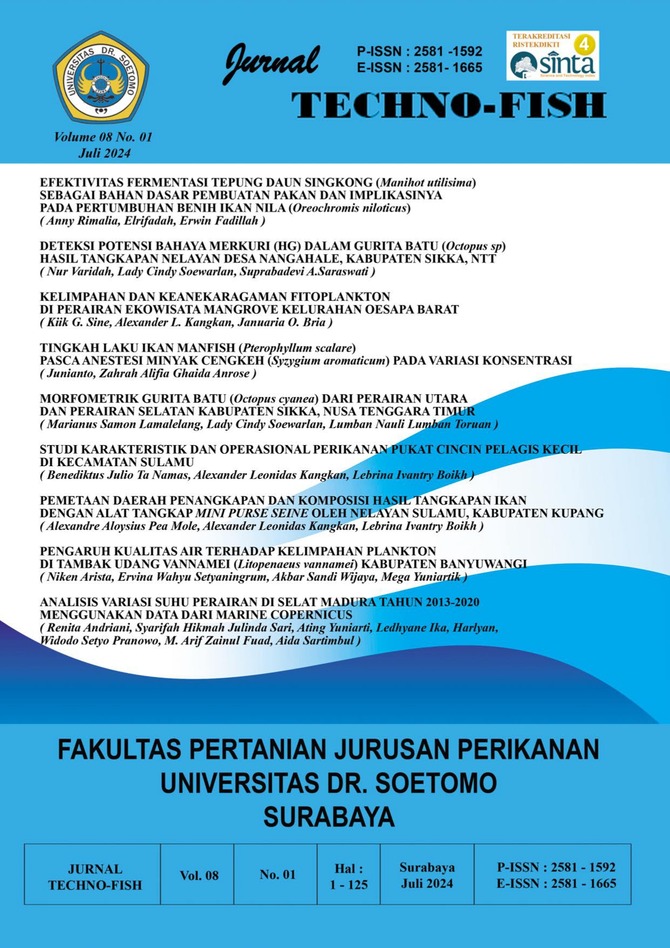Main Article Content
Abstract
The purpose of this study was to determine the morphometric characteristics of octopus cyanea from Northern Waters and Southern Waters of Sikka District. This study was carried out from July to August 2023 by taking samples of octopus caught by Octopus fishermen in Nangahale Village. Observations and measurements of morphometric characters were carried out at the capture site and also those landed in Nangahale Village. The morphometric characters observed in male octopuses were 15 characters and female octopuses were 14 characters. The number of octopus samples from Northern Waters as much as 42 tails (male 24 tails and female 18 tails) while the origin of the Southern Waters of 70 tails (male 37 tails and female 33 tails). The methods used in this study are survey and observation techniques. T-test results using the help of Microsoft Excel software show that are 10 characters differ significantly from the two Waters. Based on morphometric results O.cyanea females in Southern and Northern Waters tend to have a larger body size than O. cyanea males in Southern Waters and Northern Waters. While the results based on the location of the study, O.cyanea in Northern Waters have a larger body size than octopuses in Southern Waters but the average body weight tends to be the same. This characteristic difference is only based on several characters that are differentiators, which means that overall they tend to have similarities.
Article Details

This work is licensed under a Creative Commons Attribution-NonCommercial-NoDerivatives 4.0 International License.

This work is licensed under a Creative Commons Attribution-NonCommercial-ShareAlike 4.0 International License
References
- Alcantar S.G., Montes R.E., Plata G.D., dan Coronado J.A.F. (2020). “Growth and Sex Ratio of Octopus Paroctopus Digueti (Perrier & Rochebrune, 1894) in a Wild Population.†Croatian Journal of Fisheries 78(2):53–68. doi: 10.2478/cjf-2020-0006.
- Arkhipkin, A. I., Bizikov V.A., Doubleday Z.A., Laptikhovsky V.V., F. Lishchenko F.V., Raya C.P., dan Hollyman P.R. (2018). “Techniques for Estimating the Age and Growth of Molluscs: Cephalopoda.†Journal of Shellfish Research 37(4):783–92. doi: 10.2983/035.037.0409.
- Balansada, A.R., Medy O., dan Frans L..(2019). “Identifiksi dan Habitat Gurita (Cephalopod)dari Perairan Salibabu, Kabupaten Kepulauan Talaud.†Jurnal Pesisir dan Laut Tropis 7(3):247. doi: 10.35800/jplt.7.3.2019.24742.
- Beku, M. M., Sine K.G., dan Ayubi A.A. (2021). “Ukuran Layak Tangkap Kepiting Bakau (Scylla spp.) Hasil Tangkapan Nelayan Di Desa Tanah Merah, Kecamatan Kupang Tengah, Kabupaten Kupang, Provinsi Nusa Tenggara Timur.†Jurnal Bahari Papadak 2(2):42–48.
- Bita, F., Yahya dan Saraswati S.A. (2022). “Ciri-ciri Morfometrik Hasil Tangkapan Lampara Nelayan di Kelurahan Namosain, Kecamatan Alak, Kota Kupang.†3(1):172–80. https://ejurnal.undana.ac.id/index.php/JBP/index
- Bouth, H.F., Tatiana S.L., Françoise D.D.L, dan Jorge E.L.O. (2011). “Atol Das Rocas: An Oasis for Octopus Insularis Juveniles (Cephalopoda: Octopodidae).†Zoologia (Curitiba) 28(1):45–52. doi: 10.1590/S1984-46702011000100007.
- Courage, K. H. (2013). Octopus! The Most Mysterious Creature in the Sea. New York, USA: Penguin Group (USA) LLC.
- FAO, FAO. (2022). The State of World Fisheries and Aquaculture 2022. FAO. http://www.fao.org/documents/card/en/c/cc0461en
- Forsythe J. W. (1993). “A working hypothesis of how seasonal temperature change may impact the field growth of young cephalopods.†Recent Advances in Cephalopod Fishery Biology 133–43. https://cir.nii.ac.jp/crid/1570854174264909440
- Garcia, A. (2010). Comparative Study Of The Morphology And Anatomy Of Octopuses Of The Family Octopodidae. Auckland: Earth & Oceanic Sciences Research Institute, Auckland University of Technology. https://hdl.handle.net/10292/1379
- Herwig, J.N., Martial D., John D.R., Jayson M.S., Monica G., dan Andrew J.H. (2012). “Using Age-Based Life History Data to Investigate the Life Cycle and Vulnerability of Octopus Cyanea†disunting oleh S. C. A. Ferse. PLoS ONE 7(8):e43679. doi: 10.1371/journal.pone.0043679.
- Heukelem, WilliamF. Van. (1973). “Growth and Lifeâ€span of Octopus Cyanea (Mollusca: Cephalopoda)*.†Journal of Zoology 169(3):299–315. doi: 10.1111/j.1469-7998.1973.tb04559.x.
- Hutagaol, I., Redjeki S., dan Susilo E. (2019). “Morfometri Octopus Vulgaris Cuvier, 1797 (Cephalopoda : Octopodidae) Dari Perairan Popisi, Pulau Banggai Laut, Sulawesi Tengah.â€Journal of Marine Research 8:149 56.https://ejournal3.undip.ac.id/index.php/jmr
- Junedi, E. A., Omar S.B., Suwarni, dan Umar M.T. (2020). “Analisis Morfometrik Gurita Batu Octopus Cyanea Gray, 1849 Asal Perairan Selat Makassar Dan Teluk Bone.†Hlm. 145–54 dalam Prosiding Simposium Nasional VII Kelautan dan Perikanan. Makasar: Fakultas Ilmu Kelautan dan Perikanan, Universitas Hasanuddin.
- Kenedi, M. I. (2022). “Gurita, Salah Satu Primadona Ekspor Perikanan Indonesia. Retrieved from â€https://econusa.id/id/ecoblog/gurita-salah-satu-primadona-ekspor-perikanan indonesia/
- Mather, J.A., Anderson R.C., dan Wood J.B. (2010). Octopus: the ocean’s intelligent invertebrate. Portland, Or: Timber Press.
- Norman, Mark D. (1991). “Octopus Cyanea Gray, 1849 (Mollusca:Cephalopod) In Australian Waters:â€20 38. https://www.ingentaconnect.com/content/umrsmas/bullmar/1991/00000049/f0020001/art00004
- Osman, I. H., Gabr H.R., El-Etreby S., dan Mohammed S. (2014). “Morphometric Variations and Genetic Analysis of Lessepsian Migrant Octopus Aegina (Cephalopoda:Octopodidae.†JKAU 25:23–40. doi: DOI :10.4197/Mar. 25-2.2.
- PDSPKP, H. D. (2022). “Direktorat Jenderal Penguatan Daya Saing Produk Kelautan Dan Perikanan.â€https://kkp.go.id/djpdspkp/artikel/47840-ekspor-perikanan-tumbuh-10-66-di-2022
- Raberinary, D., dan Benbow S. (2012). “The Reproductive Cycle of Octopus Cyanea in Southwest Madagascar and Implications for Fisheries Management.†Fisheries Research 125–126:190–97. doi: 10.1016/j.fishres.2012.02.025.
- Riad, R dan Howaida R.G. (2007). “Comparative Study On Octopus Vulgaris (Cuvier, 1797) From The Mediterranean And Red Sea Coasts Of Egypt.†33:140–46.
- Roper, C. F., dan Voss G.L. (1983). “Guidelines For Taxonomic Descriptions Of Cephalopod Species.†Hlm. 49–63 dalam Memoirs of the National Museum Victoria. https://repository.si.edu/bitstream/handle/10088/11335/iz_roper_1983.pdf
- Sauer, W.H. H., (2021). “World Octopus Fisheries.†Reviews in Fisheries Science & Aquaculture 29(3):279–429. doi: 10.1080/23308249.2019.1680603.
- Soewarlan, L.C., Toruan L.N.L., Saraswati S.A. (2023). “Analisis kandungan proksimat Octopus cyanea dari perairan Nusa Tenggara Timur: Analysis of the proximat content of Octopus cyanea from the East Nusa Tenggara waters.†Jurnal Pengolahan Hasil Perikanan Indonesia 26(2):251–59. doi: 10.17844/jphpi.v26i2.44821.
- Suleman, dan Djonu A. (2022). “Pengukuran Morfometrik Ikan Tembang (Sardinella fimbriata) di Perairan Kupang.†Jurnal Salamata.2-5
- Tarigan, D.J, dan Simbolon D. (2020). “Sosial Dan Ekonomi Nelayan Gurita Berdasarkan Indikator Eafm Di Kabupaten Banggai Laut.â€Jurnal Kemaritiman: Indonesian Journal of Maritime. 1.1(1):1–10.
- Valavanis, V. D. (2003). Geographic Information Systems in Oceanography and Fisheries. 1st ed. Boca Raton: CRC Press.
